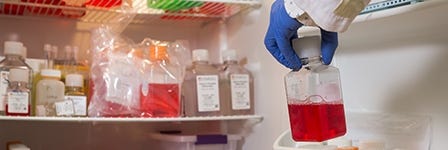How to Keep Your Lab Stockroom and Cold Reagents Organized

Keeping your lab inventory organized can help you minimize the risk of running out of reagents, avoid duplicate orders, and find things when you need them. Here are some lab inventory management and organization tips for your stockroom, freezers, and fridges.
Designate a Place for Everything
Make sure everything in your lab has a specific place. Designate specific, clearly-labeled storage locations for each reagent or category of reagents to ensure that newly-delivered items can easily be found by all lab members. Have a discussion with your lab mates to determine which commonly used reagents should be kept within arm's reach on the lab bench and which rarely used reagents can be stored away. You can also reduce clutter by creating a schedule for going through your reagents and removing expired and obsolete reagents from your storage space.
Label Everything
Establish a consistent labeling system that all lab members use to label aliquots and shared solutions. Don't forget to also label shelves and cupboards, which can remind people of where items belong and help keep storage areas organized. Be sure to create clear labels using alcohol-resistant markers.
Use Spreadsheets
Keep an updated lab inventory spreadsheet and ensure all lab members update this sheet when receiving new items. A basic lab inventory spreadsheet containing reagent names and ordering information (i.e. vendor, catalog number, price, etc.) can be created using Microsoft Excel or Google Sheets. Lot numbers and expiration dates may be included for good laboratory practice. When a certain reagents runs low, lab members can refer to this inventory sheet to obtain ordering information.
For larger labs, create and maintain an ordering spreadsheet where lab members can add items and quantities they need ordered for a given week. A designated member, such as the lab manager, can then order these items in bulk for the entire lab.
Aliquot Stock Reagents
Aliquot stock reagents (e.g. serum, trypsin, etc.) to ensure you have fresh, uncontaminated supplies. Whether or not it’s a shared reagent, pre-measured aliquots are an effective way to reduce the chance of source contamination. Aliquoting stock reagents into smaller volumes also helps preserve the stability of the stock reagent by reducing the number of freeze-thaw cycles of the entire stock. Label the new containers with the contents, the date it was aliquoted, and expiry date, if applicable. As a bonus, if someone from another lab needs to borrow a reagent, you can give them a pre-prepared aliquot rather than your whole stock container.
Create a Departure Checklist
Whenever someone leaves the lab, complete a “departure checklist” that includes reviewing, organizing, labeling, or discarding stored reagents . This process will minimize the accumulation of reagents stored in the lab and ensure new lab members have space to store their own supplies.
You can be more efficient by wasting less time looking for reagents buried deep in the stockroom, fridge, or freezer. Another way to increase your efficiency is by adopting more efficient technologies for your research.



